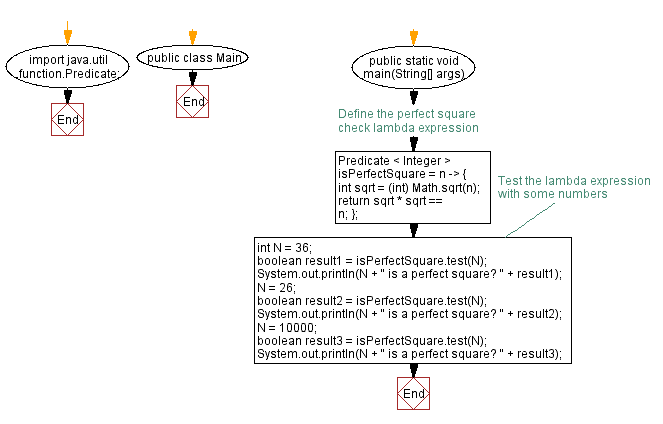Java program to check if a number is a perfect square using lambda expression
18. Check if number is a perfect square using lambda
Write a Java program to implement a lambda expression to check if a given number is a perfect square.
Note: A perfect square is an element of algebraic structure that is equal to the square of another element.
Sample Solution:
Java Code:
import java.util.function.Predicate;
public class Main {
public static void main(String[] args) {
// Define the perfect square check lambda expression
Predicate < Integer > isPerfectSquare = n -> {
int sqrt = (int) Math.sqrt(n);
return sqrt * sqrt == n;
};
// Test the lambda expression with some numbers
int N = 36;
boolean result1 = isPerfectSquare.test(N);
System.out.println(N + " is a perfect square? " + result1);
N = 26;
boolean result2 = isPerfectSquare.test(N);
System.out.println(N + " is a perfect square? " + result2);
N = 10000;
boolean result3 = isPerfectSquare.test(N);
System.out.println(N + " is a perfect square? " + result3);
}
}
Sample Output:
36 is a perfect square? true 26 is a perfect square? false 10000 is a perfect square? true
Explanation:
In the above exercise,
- Import the Predicate functional interface.
- In the main method, we define the lambda expression isPerfectSquare, which takes an integer N.
- The lambda expression checks if the square of the square root of n is equal to n. If it is, then N is a perfect square.
- We test the lambda expression by calling the test method with different numbers.
- Finally, we print the results to the console.
Flowchart:

For more Practice: Solve these Related Problems:
- Write a Java program to implement a lambda expression that checks if a number is a perfect square using Math.sqrt and floor.
- Write a Java program to create a lambda that verifies the perfect square property by squaring the rounded square root.
- Write a Java program to implement a lambda that filters a list of numbers and retains only those that are perfect squares.
- Write a Java program to chain lambda expressions to check for perfect squares and then sum them from a given list.
Go to:
PREV : Find longest and shortest string using lambda.
NEXT : Find 2nd largest/smallest in array using lambda.
Live Demo:
Java Code Editor:
Improve this sample solution and post your code through Disqus
What is the difficulty level of this exercise?
Test your Programming skills with w3resource's quiz.
